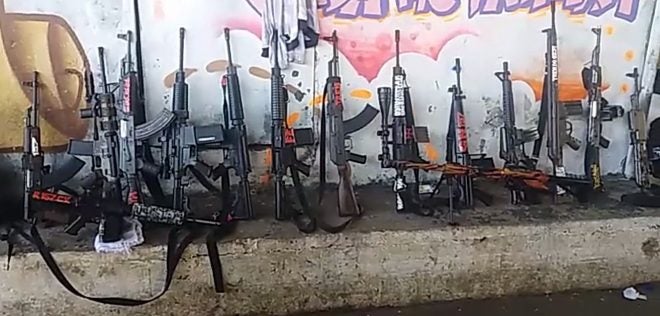Every once in a while, TFB has been showing images of the huge variety of firearms used by criminals in Brazil, seized by authorities or otherwise. Unlike the country’s law abiding and tax paying citizens, to whom firearms of even in the “permitted” calibers are all virtually out of reach due to economic and bureaucratic barriers, the (very) bad guys have no restrictions whatsoever, as demonstrated by show-off videos and pictures posted by them in the social media and by the actual seizing of firearms by police agencies on a nationwide basis.
I’d like to comment that things were very, very different at the initial stages of my gun scribe career, that is, in the early 1980s. When PD friends asked my assistance in the ID of occasional, rarer (here, at least) species of armament seized from criminal hands, I’d just browse my reference books – Jane’s Infantry Weapons, in special – to come to a quicker, more detailed answer. “It’s a Colt AR-15 or M16” or “an AK made in a specific Iron Curtain country”, plus SMGs from a dozen or so manufacturers. What about homemade/DIY/improvised firearms? Very few would emerge, and just once in a while.
Nowadays, whenever I come across pics of seized firearms in this neck of the woods, I only generally know that I’m looking at, say, AR or AK “platforms” (the accepted term to describe the basic design), whose exact origins are hard to pinpoint with accuracy. Even when I manage to lay my hands on the actual specimens, determining their exact origin may become a serious problem. So, that’s why this senior writer will keep posting (if you’re interested) such material here: younger, fresher and Internet-expert readers may find substance to carry out additional research and come up with adequate IDs and details. Enjoy!
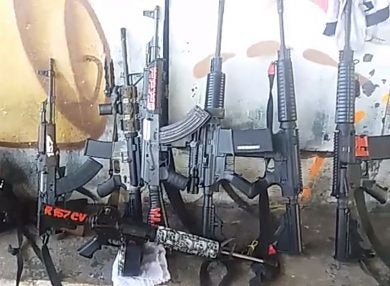
This is a partial and closer view of this article’s featured picture, a capture from a social media video recently aired. In addition to the usual 7.62x39mm AKs and 5.56x45mm ARs, Rio’s drug traffickers are increasingly using 7.62x51mm Armalite AR-10s, as shown.
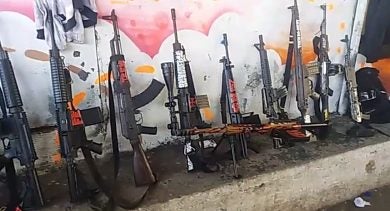
Less common rifle types here are the (HK?) G3 (third gun from right) and the FAMAE/SIG SG-542 (fifth from right), both in 7.62x51mm. For heavier criminal work, there’s a decorated .50 BMG Safety Harbour Firearms bolt-action rifle lying on the ground.
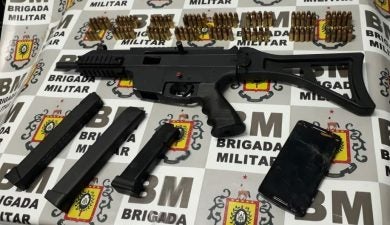
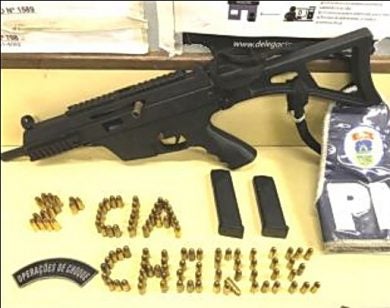
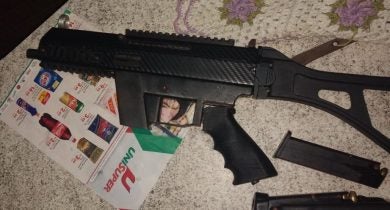
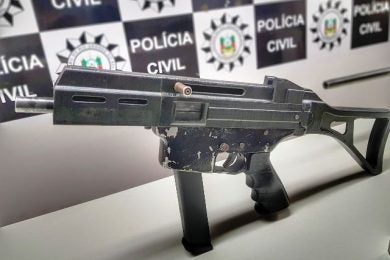
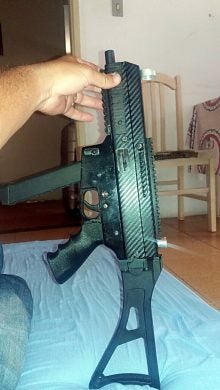
Several examples of this 9x19mm clandestine-made subgun have been seized in Rio Grande do Sul by that state’s Brigada Militar (Military Brigade). It will be noticed that it sports a G36-type folding stock (maybe, an airsoft variant) and that small design variations (e.g. shape of the magazine housing, external body finish) are incorporated. Yes, the ejection port is… to the left!
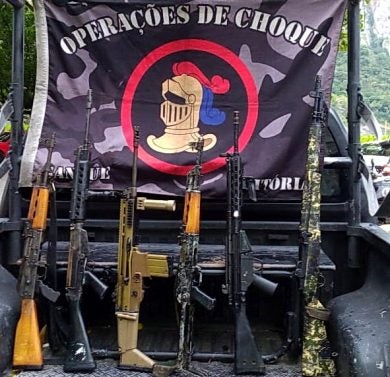
This very eclectic group of rifles recently fell to the hands of PMERJ’s (Polícia Militar do Estado do Rio de Janeiro) Batalhão de Choque (Shock Battalion) after a recent firefight (left to right): 7.62x39mm fixed stock AK, 7.62x51mm FAL with a more ventilated handguard and vertical foregrip, 7.62x51mm FN SCAR 17S with a vertical foregrip (pistol grip lost in combat…), a foldable-stock AK, a 7.62×51 (clone?) G3, and what appears to be an M1 Garad in war paint, rather than. a 7.62x51mm Springfield Armory M1A SOCOM 16.
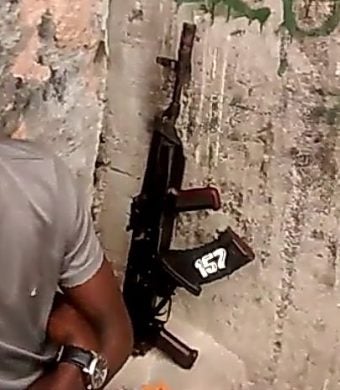
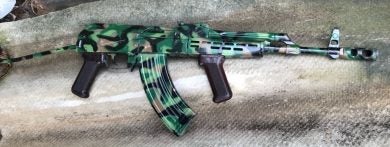
The 7.62x39mm AMD (Automata Módosított Deszant) -65, the Hungarian-made AK derivative, is occasionally found in the wrong hands here, sometimes sporting colorful finishes. It’s easily identified by such items as the canted foregrip, the flimsy metal folding stock, the two-chamber muzzle brake/compensator, and the ventilated steel handguard.
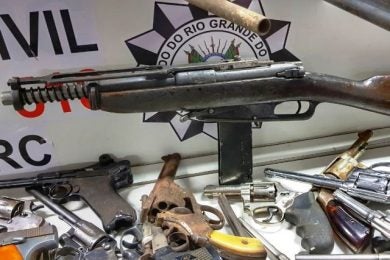
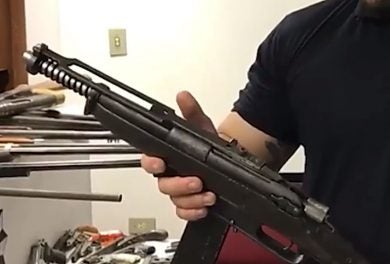
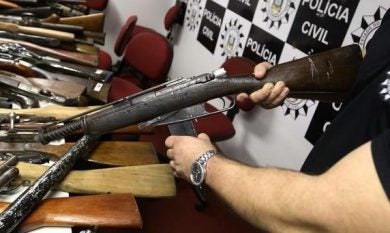
This most unusual contraption seized last March in an underground gun shop in Porto Alegre, Rio Grande do Sul State, apparently started life as an old bolt-action rifle (Carcano, Mosin Nagant, from de general shape of the fixed box magazine?) and was transformed into a semi-auto gun of unreported chambering. It will be noticed that a recoil spring was added around the barrel with two external bars connecting it to top of the (possible) blowback bolt. A detachable box magazine was used.
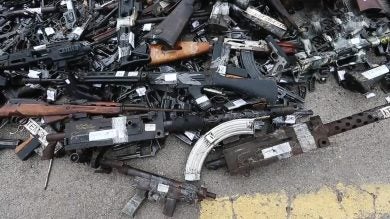
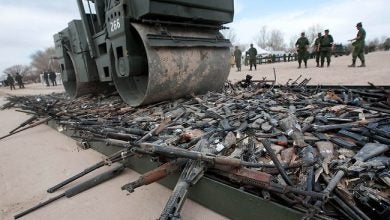
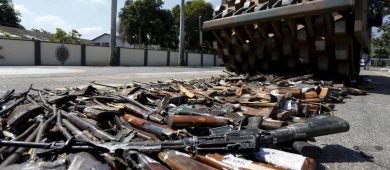
The final destination of the vast majority of firearms kept in storage following the legal procedures of the crimes involved: thousands are regularly crushed by Brazilian Army roller machines, with the resulting scrap going to metallurgical furnaces for recycling purposes. The author just hopes (in vain, most probably…) that firearms of historical significance are eventually preserved.
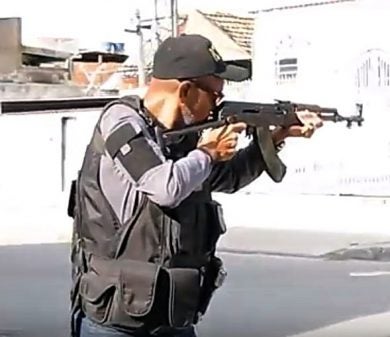
Occasionally, surviving examples of confiscated guns are seen in LE hands , as in the case of this PCERJ – Polícia Civil do Estado do Rio de Janeiro agent with a Chinese Type 56 AK variant (note missing folding bayonet) during a recent operation at the Acari community. (Photo: courtesy, Oyoy Kanamox)
Higher-res pix here: https://imgur.com/a/31qcB9d
 Your Privacy Choices
Your Privacy Choices